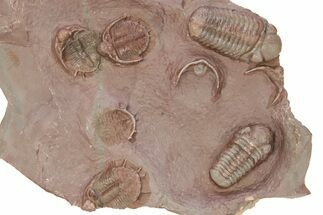Cluster Of 20+ Struveaspis & Austerops Trilobites - Jorf, Morocco
This is a gorgeous cluster of over 20 small, phacopid trilobites from Jorf, Morocco. Most of them are Struveaspis, but there are two Austerops hanging out in the mix. They are mostly preserved dorsally and prone with two ventral specimens. The entire cluster measures 6.4 x 5.5" with the largest trilobite being about 1.1" long. Only one trilobite has any significant restoration along its axis. A really beautiful piece.
Trilobites are collected from a 15-meter-thick section about 6kilometers northwest of Jorf, Morocco. Unlike many other localities, these rocks do not have distinct deposition layers, but rather are massive. They likely represent a gigantic "mud mound" that formed at the base of a volcanic island due to mud slides. The rock is very silicified, almost like a chert, and can be quite colorful. The actual shells on the trilobites are translucent: the trilobite tends to be the color of the rock it sits on.
Because the rock contains a large amount of silica, it is extremely hard, and preparing trilobites from the site is difficult since the rock does not separate well from the shell. Within the 15-meter section, only about two meters have been heavily collected, so occasionally this site will produce some extremely rare and one-of-a-kind specimens collected in float from the other layers.
Because the rock contains a large amount of silica, it is extremely hard, and preparing trilobites from the site is difficult since the rock does not separate well from the shell. Within the 15-meter section, only about two meters have been heavily collected, so occasionally this site will produce some extremely rare and one-of-a-kind specimens collected in float from the other layers.
About Trilobites
Trilobites are an extinct class of marine arthropods that thrived for nearly 270 million years, from the early Cambrian to the end of the Permian period (around 521 to 252 million years ago). They are one of the most successful and diverse groups in the history of life, with over 25,000 described species spanning a wide range of sizes, shapes, and ecological niches. Known for their distinctive, segmented exoskeletons, trilobites provide invaluable insights into the evolutionary history of arthropods and the dynamics of ancient marine ecosystems.
Trilobites are an extinct class of marine arthropods that thrived for nearly 270 million years, from the early Cambrian to the end of the Permian period (around 521 to 252 million years ago). They are one of the most successful and diverse groups in the history of life, with over 25,000 described species spanning a wide range of sizes, shapes, and ecological niches. Known for their distinctive, segmented exoskeletons, trilobites provide invaluable insights into the evolutionary history of arthropods and the dynamics of ancient marine ecosystems.
$1,795
SPECIES
Struveaspis bignoni
LOCATION
Jorf, Erfoud, Morocco
FORMATION
Bou Tchrafine Formation
SIZE
Rock 6.4 x 5.5"
CATEGORY
SUB CATEGORY
ITEM
#244128
We guarantee the authenticity of all of our specimens.
 Reviews
Reviews
















